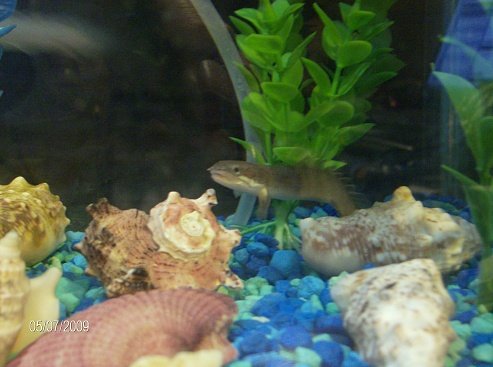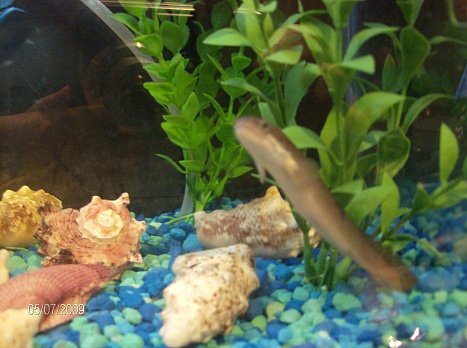FEEDING & NUTRITION
Now that you have a bichir what does it eat? In their natural habitat bichirs normally eat small fish,various insect larvae and invertabrates.Bichirs are generaly non agressive ambush predators but also oppurtunistic scavengers.Objects to big to be consumed whole are often "deathrolled" till
small parts are twisted and ripped off the carcass.The key here is to balance the diet thru a variety
of foods with an eye on total nutrition.A varied diet is a good diet for your fish and yourself.
Now then what can we feed them? You actually have several options and They will be listed below
The freezer at your local fish store is a smorgasboard of foods which should include
silversides or lancefish
mysis shrimp
brine shrimp
krill
bloodworms
tubifex worms
squid
beefheart
Simply thaw and feed
Your local market can be a great source of foods check the seafood section of the freezer
You can use just about any foods you find there including
mussels
shrimp
most fish filets (avoid salmon i think its to oily)
Available at the butcher counter or they should be able to order it for you
beefheart
and yes chicken gizzards
to prepare the above cut it into strips and remove any fat you can find
fish do not digest mammialian fat well
Live foods include
some frog species(some frogs release a nasty chemical when bitten)
tadpoles
African dwarf frogs are safe and part of the natural diet
ghost shrimp
earthworms
mealworms feed only the recently shed(white) ones the chiton in the exoskeleton
can be hard to digest and in some can result in intestinal blockages.
There is really no reason to feeders except as the ocassional treat.
Various live fish and fry can be used for foods.Caution here unless you raise them
any commercialy bought feeders usually rosie reds/tuffies (the albino form of fat head minnows),
guppies,bait minnows etc.need to be quarantined before feeding them to your fish for several reasons.
reason 1 They are kept in horrible conditions
reason 2 They are often diseased
reason 3 They often are carriers of parasites
During quarantine dispose of the obviously sick or diseased.The remaining ones feed quality
foods a healthy feeder is of course better for your fish.
Goldfish just generaly are poor feeders and should be avoided. they are oily not very nutritious and constant feed of them causes faty deposits on the liver leading to premature deaths.They also contain very high levels of Thiaminase a destroying hormone.While many fish used as feeders contain this goldfish seem to have an abundance of it.Another issue is a spine at the front of the dorsal fin which can lead to problems if the goldfish is swollowed the wrong way (tailfirst).Yet another reason not to use goldfish,goldfish farms utilize copper meds in suspension form to combat diseases in the feeders associated with overcrowding.These copper meds are retained by the feeders for long periods after they leave the farms.Most lfs invariably retain all or part of the feeders shipping water when the feeders are loaded into their bins/tanks. And copper does not dissapate from a closed system.
The key is to balance the diet with a variety of foods listed above not just 1 or 2 items and skipping a meal once you notice a decline in growth rate is good for fish.The sad truth is we as hobbyists tend to overfeed our charges
Pellitized foods
Can be found in various diameters and forms include sinking and floating pellets and sticks
shrimp pellets
worm pellets
even pellets for cichlids will work
spirulina sticks
brine shrimp sticks
Algae wafers(some eat them some just look at them)
When feeding pellets how much to feed?
Under 7''I let them eat as much as they want several small feedings when young are better then 1 or 2 large feedings.I let juvies eat till theres a slight bulge to there bellies
This really applies to bichirs 7''+ I feed mine twice a day skipping at least one day a week
Approx. 80% of their diet is a quality pellet food the rest frozen with the ocassional live feeders after quarantine of course.
How manyPellets?
I start off with total 2 pellets per inch of fish eg. a 7'' fish gets 7 pellets in the A.M. and 7 in the evening feeding is then adjusted up or down so all pellets are consumed.Remember a nice round bichir is a happy bichir
Read the labels and look for this information
NUTRITION FOR CARNIVORES
Below are the agreed upon nutritional requirements for predatory fish
below that is a list of necessary vitamins usually supplied and just for informational
purposes.
PROTEIN:: 45% or more (this would be the ideal)
FAT:: 3% Min. to 6% Max.
FIBER 2% Min. to 4% Max
VITAMINS and what they do
(If you want to suppliment vitamins use only vitamin products developed for fish
do not use vitamnins developed for humans use.)
-------------------------------------------------------------
Fat Soluble Vitamins
VITAMIN A promotes cellular growth
Functions: - normal vision, cell growth and resistance to infection
Deficiencies: - poor growth, poor vision, abnormal bone formation and
hemorrhaging at the base of the fins
VITAMIN D3 important for developing bone
Functions: - calcium blood levels (?)
Deficiencies: - unknown
VITAMIN E important for the development of the sex organs in breeding fish
Functions: - antioxidant, may paly a role in muscle cell respiration
Deficiencies: - anemia and poor growth
-------------------------------------------------------------
Water Soluble Vitamins
VITAMIN (B1)
Functions: - Thiamine-aids growth, digestion and fertility, nervous system
Deficiencies: - poor appetite, muscle atrophy, convulsions, loss of
equilibrium and poor growth
VITAMIN B2 Riboflavin- regulates enzymes
Functions: - vision, protein metabolism and enzyme functioning
Deficiencies: - photophobia, cloudy lens, dim vision, abnormal
colouration of the iris, striated constrictions on the
abdominal wall, dark pigmentation, poor appetite,
anemia and poor growth
VITAMIN B3 Nicotinic Acid-needed for proper digestion
Functions: - plays an important role in lipid, protein and amino
acid metabolism
Deficiencies: - loss of appetite, poor growth, lesions in colon,
erratic motion and weakness, edema of stomach and
colon
VITAMIN B5 Pantothenic Acid-controls metbolism and hormones
Functions: - adrenal functioning, cholersterol production, normal
physiology and metabolism
Deficiencies: - poor growth, sluggishness, clubbed gills, loss of
appetite, hemmorhagic skin and cellular atrophy
VITAMIN B6 Pyroxidine-enzymes and metabolism of protein
Functions: - plays a vital role in enzyme systems and protein
metabolism
Deficiencies: - nervous dissorders, fits, loss of appetite, poor
growth, rapid and gasping breathing, flexing of
opercles and hyperirritability
VITAMIN B12 Cyanocobalamin- metabolism
Functions: - enzyme systems, cholesterol metabolism
Deficiencies: - poor appetite, poor growth, anemia and dark
pigmentation
VITAMIN C Ascorbic Acid- formation fo teeth and bones , healing wounds and formation of
cartillage
Functions: - enzyme systems, bone, tooth and cartilage formation
and healing
Deficiencies: - hemorrhagic shin, kidneys, liver, intestine and muscle
tissue, eye lesions and scoliosis of the spine
VITAMIN H Biotin- promotes cell growth
Functions: - enzyme systems, purine and lipid synthesis, oxidation
of lipids and carbohydrates
Deficiencies: - loss of appetite, poor growth, anemia, skin lesions
and muscle atrophy
VITAMIN M Folic Acid- formation of blood and metabolism
Functions: - blood cell formation, blood glucose regulation and
fish metabolism
Deficiencies: - poor growth, lethargy, dark skin, anemia and fragility
of the caudal fin
CHOLIN growth and breakdown nutrients (fat) regulating glucose
Functions: - good growth and food conversion
Deficiencies: - poor growth, poor food conversion, hemorrhagic kidney
and intestine
INOSITOL permeability of cell membrane
Deficiencies: - poor growth, distended stomach, skin lesions and
increased gastric emptying time
p-AMINOBENZOID ACID- stimulates growth (not proven essential)
Deficiencies: - no abnormal indication in growth, appetite and
mortality
Estimated Minimum Vitamin Requirements for aquarium fish
Vitamin A 10,000 IU
Vitamin D 2,400 IU
Vitamin E 100 Mg
Vitamin K 10 Mg
Vitamin B1 10Mg (Thiamine)
Vitamin B2 10Mg (Riboflavin)
Vitamin B3 50Mg (Niacin)(nicotinic acid and vitamin B3)
Vitamin B5 50MG (Pantothenic acid)
Vitamin B6 10Mg (Pyroxidine)
Vitamin B7 1Mg (Biotin aka vitamin H)
Vitamin B9 10Mg (Folate)
Vitamin B12 0.02Mg (Cyanocobalamin)
Vitamin C 250Mg (Ascorbic Acid)
Inositol 440Mg
Choline 2.00Mg
free in water the following happens After 30 seconds this applies to
water soluble vitamins only
Vitamin b6 loss 15%
Folic Acid loss 20%
Choline loss 30%
Panothenic acid loss 50%
Vitamin C loss 70%
Vitamin B12 loss 90%


